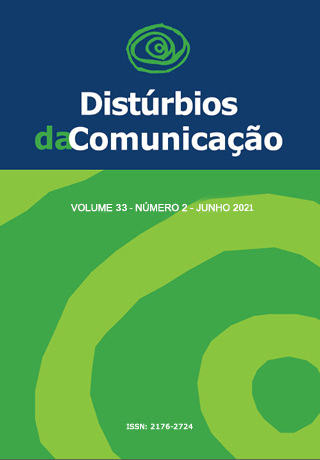Analysis of cervical and ocular VEMP responses in healthy individuals
DOI:
https://doi.org/10.23925/2176-2724.2021v33i2p213-220Keywords:
Vestibule, Labyrinth, Ear, Inner, Saccule and Utricle, Evoked Potentials, Motor, Vestibular Function TestsAbstract
Introduction: Vestibular evoked myogenic potentials (VEMP) are electrophysiological responses that can provide information on the otolithic organs saccule, utricle and of the vestibular nerve. VEMP is a complementary exam to the vestibular assessment; it is a quick exam, easy to apply and objective. Purpose: to analyze the parameters of latency, amplitude, threshold and asymmetry index of the cervical (cVEMP) and ocular VEMP (oVEMP) responses of individuals without vestibular complaints. Methods: cross-sectional study carried out with 53 individuals of both genders without hearing and vestibular complaints. Results: response symmetry was found in the latencies, amplitudes and thresholds of cVEMP test responses. However, there was a difference between the ears of the P15 latency of the oVEMP exam, and this was greater on the right ear in females. Conclusion: symmetry was found in the responses of all cVEMP evaluated parameters. There was asymmetry in oVEMP P15 latency only in female patients. The response thresholds found in the cVEMP and oVEMP tests were equal or greater than 75 dBHL.
Downloads
References
Silva TR, Resende LM, Santos MAR. Potencial evocado miogênico vestibular ocular e cervical simultâneo em indivíduos normais. CoDAS. 2016; 28: 34-40.
Kantner C, Gürkov R. Characteristics and clinical applications of ocular vestibular evoked myogenic potentials. Hear Res. 2012; 294: 55-63.
Colebach JG, Halmagyi GM, Skuse NF. Myogenic potentials generated by a click- voked vestibulocollic reflex. J Neurol Neurosurg Psychiatry. 1994; 57: 190-7.
Rey-Martínez J,Pérez-Fernández N, Guzmán RBD. ¿Cómo analizar un potencial evocado miogênico vestibular? Aplicación de un método no lineal. Acta Otorrinol Esp. 2011; 62: 126-31.
Cunha LCM, Labanca L, Tavares MC, Gonçalves DU. Vestibular evoked myogenic potential (VEMP) with galvanic stimulation in normal subjects. Braz J Otorhinolaryngol. 2014; 80: 48-53.
Chang CM, Young YH, Jaw FS, Wang CT, Cheng PW. Degeneration of the vestibular nerve in unilateral Meniere’s disease evaluated by galvanic vestibular-evoked myogenic potentials. Clin Neurophysiol. 2017; 128: 1617-24.
Felipe L, Santos MAR, Gonçalves DU. Potencial Evocado Miogênico Vestibular (VEMP): avaliação das respostas em indivíduos normais. Pró-Fono R. Atual. Cient. 2008; 20(4): 249-54.
Silva TR, Santos MAR, Resende LM, Labanca L, Caporali JFM, Sousa MR, Gonçalves DU. Aplicações dos potenciais evocados miogênicos vestibulares: revisão sistemática de literatura. Audiol Commun Res. 2019; 24: e2037.
Ribeiro MBN. Mancini PC. Comparação das respostas do VEMP cervical e ocular em indivíduos com e sem doenças otoneurológicas. Distúrb Comun, 2020; 32(3): 406-413.
Tateyama T. Potenciais evocados miogênicos vestibulares respostas em indivíduos normais de acordo com a idade [dissertação]. São Paulo: Universidade Anhanguera de São Paulo; 2015.
Akin FW, Murnane OD, Tampas JW, Clinard CG. The effect ofage on the vestibular evoked myogenic potential and sterno-cleidomastoid muscle tonic electromyogram level. Ear Hear.2011; 32: 617-22.24.
Ribeiro MBN, Morganti LOG, Mancini PC. Avaliação do efeito da idade sobre a função vestibular por meio do Teste do Impulso Cefálico (v-HIT). Audiol Commun Res. 2019; 24: e2209.
JERGER, J. Clinical experience with impedance audiometry. Arch Otolaryngol, Chicago. 1970; 4: 311-24.
Ochi K, Ohashi T, Nishino H. Variance of vestibular-evoked myogenic potentials. Laryngoscope. 2001; 111: 522-7.
Pereira AB, Silva GSM, Felipe L, Assunção ARM, Atherino CCT. Potencial evocado miogênico vestibular (VEMP). Revista HUPE. 2015; 14: 56-9.
Curthoys IS, et al. A review of mechanical and synaptic processes in otolith transduction of sound and vibration for clinical VEMP testing. J Neurophysiol. 2019; 112: 259–76.
Macambira YK, Carnaúba AT, Fernandes LC, Bueno NB, Menezes PL. Aging and wave-component latency delays in oVEMP and cVEMP: a systematic review with meta-analysis. Braz J Otorhinolaryngol. 2017; 83: 475-87.
Silva TR, de Resende LM, Santos MA. Combined ocular and cervical vestibular evoked myogenic potential in individuals with vestibular hyporeflexia and in patients with Ménière’s disease. Braz J Otorhinolaryngol. 2017; 83: 330-40.
Zuniga MG, Janky KL, Nguyen KD, Welgampola MS, Carey JP. Ocular versus cervical VEMPs in the diagnosis of superior semicircular canal dehiscence syndrome. Otol Neurotol. 2013; 34: 121-6.
Janky KL, Nguyen KD, Welgampola M, Zuniga MG, Carey JP. Air-conducted oVEMPs provide the best separation between intact and superior canal dehiscent labyrinths. Otol Neurotol. 2013; 34: 127-34.
Lamounier P, de Souza TS, Gobbo DA, Bahmad Jr. F. Evaluation of vestibular evoked myogenic potentials (VEMP) and electrocochleography for the diagnosis of Ménière’s disease. Braz J Otorhinolaryngol. 2017; 84: 394-403.
Downloads
Published
Issue
Section
License
Copyright (c) 2021 Marlon Bruno Nunes Ribeiro, Patricia Cotta Mancini

This work is licensed under a Creative Commons Attribution 4.0 International License.









